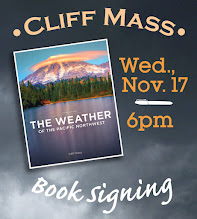The air feels different today.
Warm, humid, and with a determined breeze that should be moving a grove of palm trees.
Your skin feels moistened and supple, and temperatures will rise to near 60F in the west and as high as 70F over the Columbia Basin.
The Northwest has been transported into the subtropics for a day, the result of an odd meteorological wormhole in meteorological space/time.
This blog will explain.
Some of you may demand proof of the tropical origins of our current air....here it is!
The top figure below shows the trajectories of air over the past five days ending above Tacoma at 500 meters (red), 1000 m (blue), and 2000 m (green). All three air trajecotires come from south of 30 N west of Baja California.
The subtropics.
The bottom panel shows the heights of the air over the past five days.
The transition occurred last night.
Below are observations of wind, temperature, and moisture (dew point temperature) at the University of Washington. Early last evening, the winds switched from northeast to south and accelerated greatly, with some gusts to 15-20 meters per second (around 38 mph!). Temperature and dew point (a measure of moisture) surged upward to around 14 C (roughy 57F)
The strong pressure difference with the front will first cause a surge of powerful westerly winds in the Strait of Juan de Fuca and then strong winds, gusting to 60-80 mph, over the eastern slopes of the Cascades. The wind gust forecast for 7 PM tomorrow is shown below--pretty scary east of the Cascade crest. Expect some power outages on northern Whidbey Island and over the eastern Cascade slopes.
And behind the front, our temperatures will greatly cool, with temperatures over the western lowlands only climbing to the mid-40s for the rest of the week. Snow will return to the mountains. And skiers will hope.....
Announcement:
I will be doing a book signing and dinner event at Ivar's Salmon House in Seattle on Wednesday, November 17th (6 PM). You can come just to purchase a book and get it personalized or you can stay for a special dinner, where I will be giving a weather talk. More information on the event is found here. You need to make reservations for the dinner (only 80 spaces available). And information about the new edition of my book is here.
Half the spot are now reserved, so if you want to go, reserve a place soon.












Is there a mountain wave event possible in the Wenatchee area?
ReplyDeleteSince the late afternoon actually turned out to be dry and oddly comfortable, I decided to get out for a bike ride. The first half of the ride had me cruising while the second half had me cursing. There was a huge tree blocking the trail that wasn't there when I rode through just five days ago. Not sure if it was the wind or the rain that got to it so I'm gonna split the difference there - it was both!
ReplyDeleteOur barometer yesterday registered 1011 Millibars much of the day, varying at most at one time by 1 millibar, even with the constant wind. This morning the barometer is 998 and is still falling. Should be an interesting day.
ReplyDeleteRegarding my previous comment pertaining to barometric pressures, we live in NE Seattle, just east of View Ridge. The proximity of Lake Washington, as well as the north/south configuration of 3 lengthy ridges between Lake Washington’s valley, and Green Lake’s trough, and Maple Leaf Heights on the north, make for complex air movements as well as precipitation formation and accumulation.
ReplyDeleteAlso, if not mistaken, you are not that far from the convergent zone area anyway as I think you live towards the north end of Seattle anyway.
DeleteAt 12:47 PM Monday Nov. 15th our barometer is 996 millibars and still showing tending down. I don’t have an anemometer but while the wind has been steady much of the day I’ll suggest subjectively that that has been consistently only light and only the gusts moderately strong. We’ll see what the evening brings as the front passes.
ReplyDeleteThe front apparently passed our location at about 1:30. The rain stopped, the wind died, the clouds thinned and the barometer turned around from 996 millibars and is now, at 4:15 standing at 1006 millibars and tending up. The sky is very dramatic. Since the temperature has dropped over 5 degrees F I hazard to guess that this kind of sky indicates that a form of Convergence Zone is setting up above, east and north of us.
DeleteThank you for your unflagging curiosity and enthusiasm and for your generosity in sharing your knowledge.
ReplyDeleteOK cliff: We have a "strong front" with 42 degree air pushing out 58 degree air. In another part of the country, that kind of change (a drop of 16 degrees F) would usually produce strong frontal thunderstorms. What are we missing?
ReplyDeleteYesterday was very pleasant for a 5-mile run in Gig harbor- in shorts and a T-shirt.
ReplyDelete